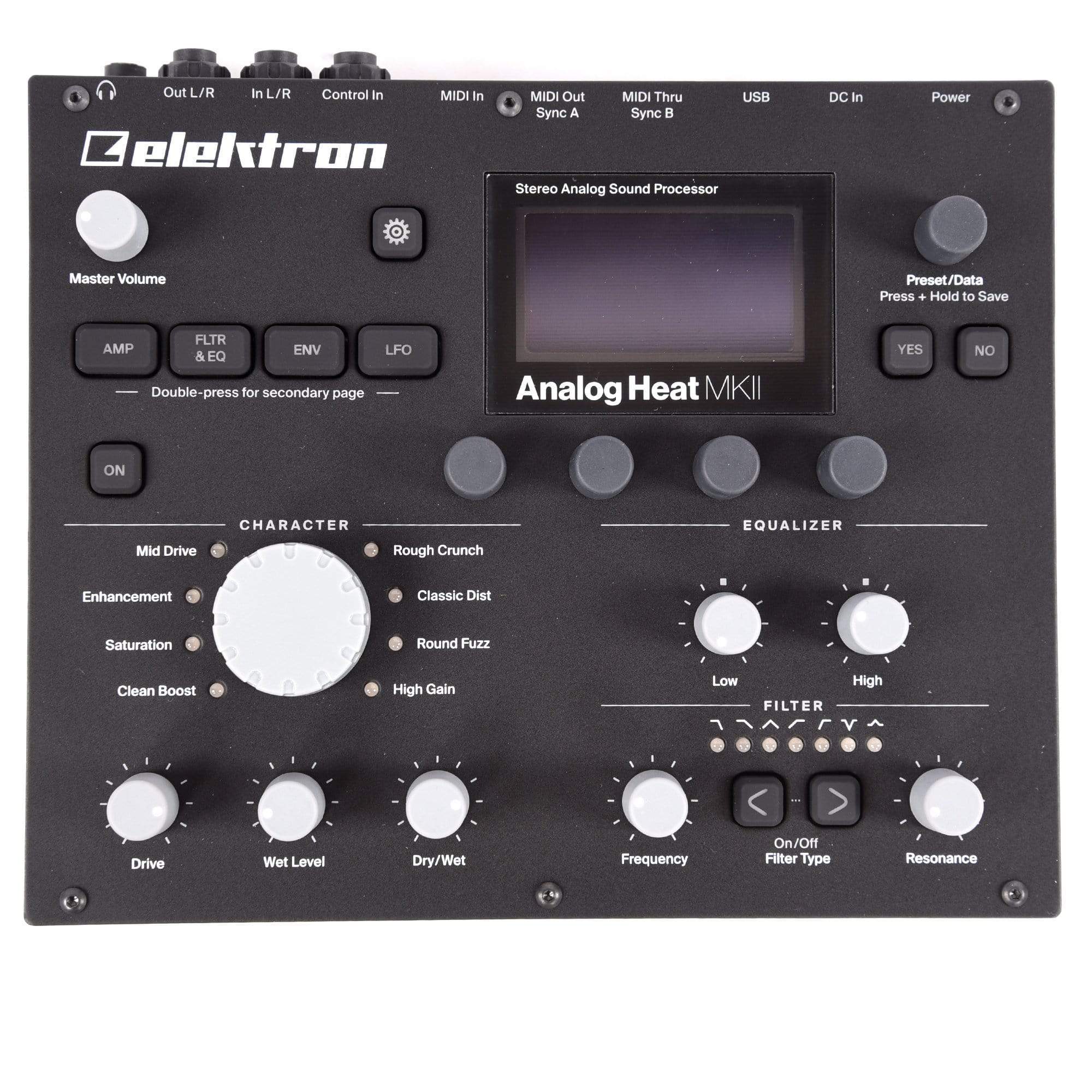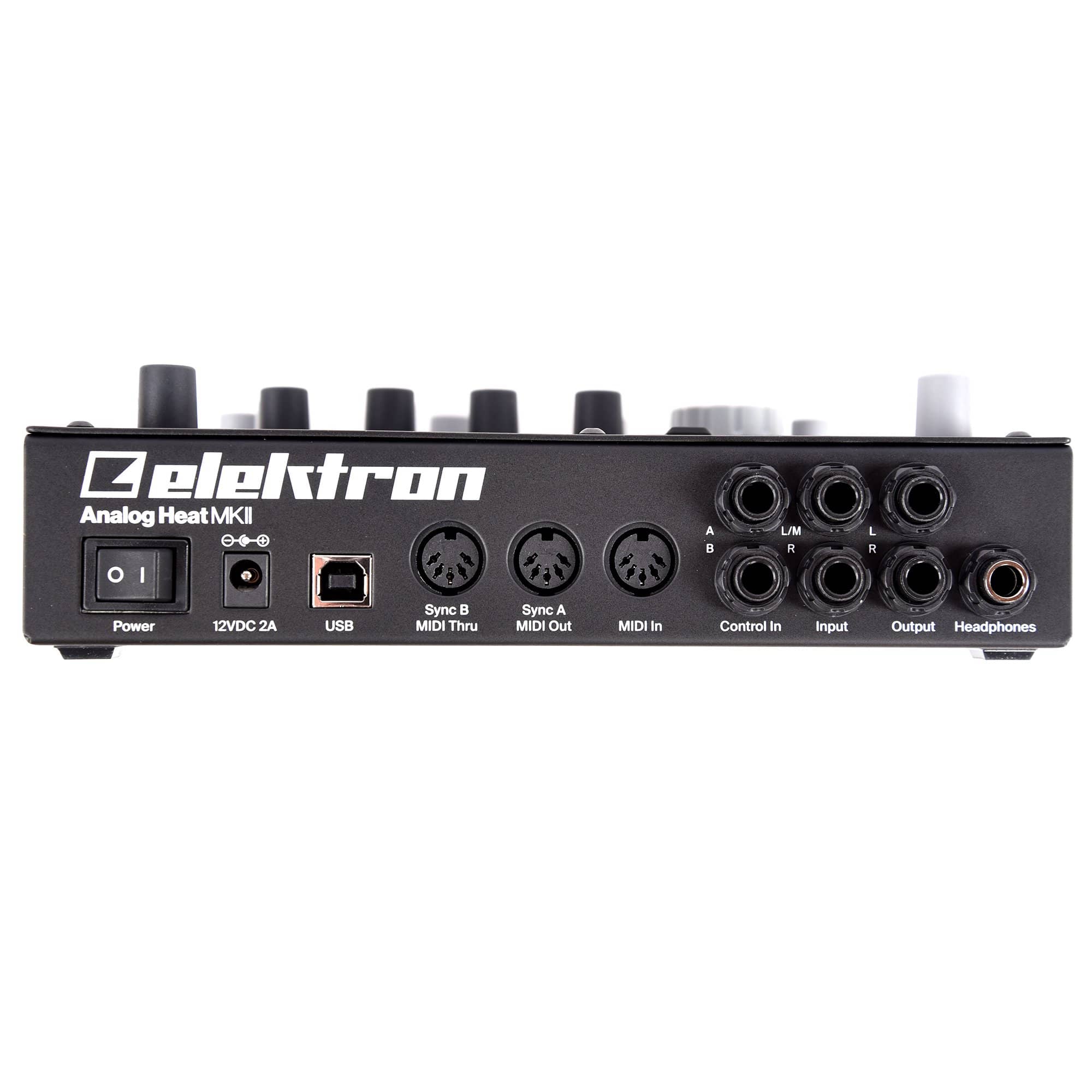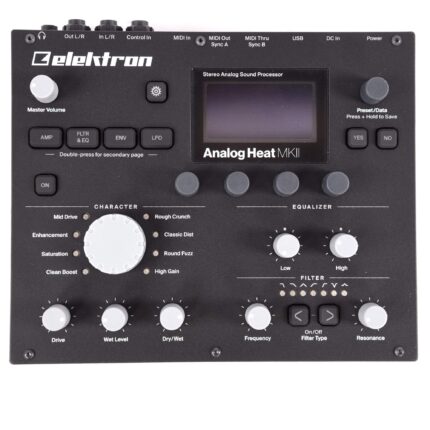| Content | Add sparkly brilliance, or grimy roughness, to any sound source. Samplers, drum machines, synths, the master bus, you name it. Analog Heat MKII is a fiery furnace destined to make your music glow.
Sound better
Take a sound, any sound. Send it through the Analog Heat MKII, try out the eight different stereo analog distortion circuits, add stereo analog filtering and EQ, and hear beautiful things unfold. New life for your existing gear.
All analog, all yours
The eight stereo analog circuits are designed to quickly access varied and powerful sound shaping. Each circuit has a distinctive way of processing sound. Clean boost, tape-like saturation, tube amp-like enhancement, overdrive, crunch, distortion, harmonic fuzz or high gain? You’ll find your favorite flavor with ease.
Brighter and better
The MKII version of the Analog Heat features improved durability and precision encoders, new tough back-lit keys and a crisp OLED screen. The display is bigger, sharper and brighter: perfect for performing in the dark. There is also additional visual feedback on the Amp, Filter, Envelope and LFO pages that makes overview and understanding of sound processing and modulation a whole lot easier.
Sound processing
- 8 × Stereo analog distortion circuits
- 1 × Stereo analog multi-mode filter (7 filter types)
- 1 × 2 band adaptable stereo analog EQ
- 1 × Assignable envelope generator/envelope follower
- 1 × Assignable LFO
Storage
Hardware
- 128×64 pixel OLED screen
- MIDI In/Out/Thru with DIN Sync out
- 2 × ¼″ balanced audio out jacks
- 2 × ¼″ balanced audio in jacks
- 1 × ¼″ stereo headphones jack
- 2 × ¼″ CV/Expression pedal input jacks
- 48 kHz, 24-bit D/A and A/D converters
- Flash-EEPROM upgradable OS
- Hi-speed USB 2.0 port
Audio outputs
- Headphones out level: +19 dBu peak
- Headphones output impedance: 36 Ω
- Impedance balanced main outputs level: +19 dBu peak
- Main outputs impedance: 440 Ω unbalanced
Audio inputs
- Balanced audio input level: +19 dBu peak
- Audio input impedance: 39 kΩ
Control inputs
- Input level: -5 V – +5 V
- Accepts CV, Expression pedals, Foot switches
Physical specifications
- Sturdy steel casing
- Dimensions: W215×D184×H63 mm (8.5×7.2×2.5″) (including audio outputs, knobs and rubber feet)
- Weight: approximately 1.5 kg (3.3 lbs)
- 100×100 mm VESA mounting holes
Included in the box
- Power Supply PSU-3b
- Elektron USB cable
Analog Heat MKII and Overbridge
Any DAW user will love Analog Heat. It is perfect for adding analog warmth and grit to digital audio. Suitable on individual tracks as well as on the master bus. It can also double as a sound card, making it perfect for the nimble studio.
- Control your Analog Heat with audio and sync using a dedicated VST/AU
- plugin
- Process DAW audio with beautiful analog stereo filtering and distortion
- Mid/Side mode lets you expand audio processing possibilities
- Analog Heat MKII can be used as a 2 in/2 out sound card
- (CoreAudio/ASIO/WDM)
- Use Analog Heat as a separate sound card, all while using the other features
- of the instrument
- Total Recall remembers all Analog Heat settings when loading a DAW project
| Radial X-Amp Active Reamper
- Active Reamp® with two outputs
- 100% discrete class-A signal path
- Transformer isolated to eliminate noise
- Variable 'set & forget' level control
The Radial X-Amp is an active Reamper™ that allows the engineer to play a pre-recorded track back through guitar amplifiers and pedals. This opens the door to explore new musical sounds and spur on the creative process so that your recording stands out.
Using the X-Amp is easy: start by recording a dry track using a high quality direct box like the Radial J48. Send the new track from your recorder via the X-Amp to your guitar amps, effect pedals or combinations thereof. Once the basic track has been recorded, replacing or adding tracks can be done well after the session player has gone home. This eliminates tiresome repetition and assures a fresh vibrant performance on the final recording. Furthermore, by driving two amps at the same time, new sounds and textures can be created while allowing you to make artistic decisions as the recording progresses.
Following the critically acclaimed Radial JD7 Injector, the X-Amp employs a unique class-A circuit design that has been optimized for use with guitars. Features include balanced line level input with LED peak indicator and level control, class-A circuit topology for optimal reach and frequency response, a transformer isolated output to eliminate hum and buzz caused by ground loops, a 180º polarity reverse switch to bring both amps into phase, and a dual ground lift switch for noise-free operation.
As with all Radial products, the X-Amp is built like a tank to provide years of trouble-free performance. An internal I-beam skeleton provides maximum protection against external stress which could cause solder points to fail. This is supplemented with an innovative bookend design that creates a protective zone around the switches, potentiometer and connectors. A full bottom no-slip pad performs double duty by keeping the X-Amp from sliding around when placed on a vibrating amplifier while also providing electrical and mechanical isolation. Reamping works equally well on bass, keyboards, drums and voice. Once you start Reamping, you will never record any other way.
The Radial X-Amp… the active Reamp® for professional recording engineers. | Effective against boredom, supporting creative sound design
A unique team play of spring reverberation, analogue multimode filtering, distortion and VCA, modulated by an ultra fast LFO and an envelope that can be triggered in flexible ways – Retroverb Lancet offers a comprehensive arsenal of many-sided effects for different applications. The spectrum by far surpasses classic reverberation, filter sweeps or overdrive because you are able to tweak and bend any parameter fast and intuitively to your liking.
Retroverb Lancet will change the way you work with effects. It becomes part of your sound engine, fires it up and will end up as essential part of your sonic signature.
Source of effectiveness
We designed Retroverb Lancet in a way that it can perfectly handle signals of any kind: Guitars, basses, synthesizers, organs or microphones. On top of that, Retroverb Lancet allows you to create percussive sounds using its crash function.
Retroverb Lancet is a real jack of all trades with character, suited for adventurous sound designers and tinkerers.
Audio Input
- max. input sensitivity: –32 dBu
- impedance: 1 MΩ
Output
- max. output level: 20 dBu
- impedance: 600 Ω
Trigger- and CV-inputs
- audio trigger
- max. input sensitivity: –32 dBu
- impedance: 1 MΩ
- gate & CRASH
- external cv
Signal-to-Noise Ratio
- direct: > 80 dB
- effect (filter completely open, no reverb): > 75 dB
Spring Tank
- number of springs: 3
- reverbration decay: between 2.75 db and 4.00 s
Filter
- modes: 24-db-lowpass, 24-db-highpass, 12-db-bandpass
- modulations sources: envelope generator, envelope follower, external CV, LFO
LFO
- frequency range: 0.05 Hz … 300 Hz
- waveforms: ramp up, ramp down, square, sine, S&H, envelope generator
Envelope Generator
- modes: AD, ASR
- attack: 1 ms … 10 s
- decay/release: 1 ms … 15 s
Miscellaneous
- power supply: external DC-adapter with 12 V/1000 mA
- dimensions: 26 cm x 14.5 cm x 8 cm (width x depth x height)
- weight: 0.75 kg
Accessories
| As with ELI’s other signal processors, the Lil FrEQ Equalizer takes a somewhat unique approach to its job. Instead of daisy chaining several equalizers and frequency processors, we combined most of the sound sculpting tools an engineer needs into a compact single rack space box, while still offering the highest performance of any design in its class.
Eight Sections of Processing
There are eight sections of processing – what other EQ offers that? Even better – in addition to a master bypass, each of the Lil FrEQ’s sections features its own dedicated bypass switch, letting you instantly A/B the effect of each section as you adjust and fine-tune them.
HIGH PASS – The High Pass section is a really easy to use sharp filter that cuts all content below one of eight preset frequencies from 30-330 Hz. This filter is very steep and has a special shape that prevents frequencies from thinning out just above the cutoff point. The corner frequency is selected using up/down buttons, and indicated by LEDs that glow softly when the section is bypassed, and brightly when the section is engaged.
HIGH & LOW SHELVING – These two knobs function similarly to the familiar “bass and treble” tone controls found on many consumer audio playback systems; however, these are designed to a much higher performance standard, providing exceptionally smooth and musical boost and cut on the high and low frequencies.
PARAMETRIC EQ – The Lil FrEQ has four sections of fully parametric EQ (LF, Lo Mid, Hi Mid and HF), with each section featuring individual gain, bandwidth (Q) and frequency controls. It may be the cleanest parametric EQ section ever produced, operating below .0007% THD (Total Harmonic Distortion) even at extremely high audio levels. Try finding those specs anywhere else!
DS (DYNAMIC EQ) – The DS section provides the highest performance, easiest to use, and possibly most natural sounding “De-esser” ever built. This powerful tool combines tunable filters with a compressor-like circuit that can help contain and control excessive high frequency content such as sibilants or other sharp transients, especially in the absence of other lower frequency content. It can also function as a one of a kind soft knee High Frequency limiter, which is one of the main things responsible for the Lil FrEQ becoming the go-to vocal EQ for engineers everywhere. It has been used on many acclaimed albums and major live performances all over the world, becoming the “go to” EQ for key tracks like lead vocals, snares, and bass. There are now dozens of hit record vocals that were processed thru the Lil FrEQ.
Frequency Response: 5 Hz to 140 kHz on transformerless inputs and outputs. Transformer output 10Hz to 110 kHz.
Dynamic Range: 120 dB from maximum output (.1% clipping) to minimum output. Greater than 110 dB signal to noise.
Distortion: Ranges between .00056% and .005% depending on mode and settings. DS section has THD < .005%.
I/O: DC coupled inputs and outputs and one transformer coupled output.
Dynamic Time Constraints: Attack is approximately .5 ms. Release .04 sec fixed internally.
Power Consumption: 15 Watts Max.
Metal Chassis: single height 1.75″ high, 10″ deep, 19″ wide. | Rupert Neve Designs Portico 542 500 Series Tape FX Standard
FEATURES
- Add depth and character to your sound
- Control the mix of pre and post tape signals
- Send signals through "True Tape" circuitry
- Silk circuit, reduces negative feedback, adding harmonic content as needed
- Red Silk accentuates the saturation in the mid and high frequencies
- Use soft clip to tame overly transient material like drums
- Provides +/- 12dB adjustment of level on incoming signal levels
TECHNICAL SPECIFICATION
Rupert Neve Designs Portico 542 500 Series Tape FX
- Line Amp Specifications (Measurements with tape circuit disengaged)
- Noise: Measured at Main Output, un-weighted, 20Hz-22kHz, Input Terminated 40 Ohms.
- Unity Gain Better than -100dBu
- Frequency Response
- Measured at +10dBu, trim at unity.
- Main Output +/- 0.25dB from 5Hz to 60Khz -2dB @ 120KHz
- Maximum Output Level 23.25dBu
- Total Harmonic Distortion and Noise:
- @ 1kHz, +20dBu output level Better than 0.0025% @ 20Hz, +20dBu output level 0.07% Typical (2nd and 3rd harmonic)
- Tape FX Specifications
- Noise:
- Measured at Main Output, un-weighted, 20Hz-22kHz, Input Terminated 40 Ohms.
- Saturation @ minimum Better than -100dBu Saturation @ maximum Better than -100dBu
- Frequency Response:
- 15 IPS, Input @ -0 dBu -3dBu @ 28kHz Saturation @ minimum 0dBu @ 10Hz +5dBu Peak @ 60Hz
- Saturation @ maximum -3dBu @ 20kHz -3dBu @ 12.5Hz +2.4dBu Peak @ 60Hz
- 30 IPS, Input @ -0 dBu -3dBu @ 120kHz Saturation @ minimum -3dBu @ 10Hz +3.15dBu Peak @ 125Hz
- Saturation @ maximum -3dBu @ 100kHz -3dBu @ 12.5Hz
- +1.3dBu Peak @ 110Hz
- Total Harmonic Distortion and Noise
- Refer to sweeps on page10 15 IPS, Input @ -0 dBu 0.4% @ 3kHz to 1% @ 175Hz typical
- Saturation @ minimum Greater than 1% below 175Hz typical
- Saturation @ maximum 1% at 6kHz typical 0.3% @ 1kHz to 3% @ 50Hz typical
- 30 IPS, Input @ -0 dBu 1% at 1kHz typical
- Saturation @ minimum 0.6% @ 400Hz 5% @ 20Hz typical
- Saturation @ maximum 1.5% @ 20kHz to 0.4% @ 1kHz typical 0.4% @ 1kHz to 2 %@ 50Hz typical
- Power requirements:
- Supplied by 500 series rack with 110-125 mA @ +/- 16V DC
| FEATURES
- 12-way precision rotary switch controls gain from 0 to 66 dB in 6 dB steps
- Continuously variable +/-6 dB level control
- Silk circuit, reduces negative feedback, adding harmonic content as needed
- Red Silk accentuates the saturation in the mid and high frequencies
- Same presence and sweetness found in standard Portico Series modules
|
Number of Channels |
Single |
|
Inputs |
1x XLR, balanced |
|
Output |
1x XLR, transformer-balanced |
|
Maximum Output Level |
+23dBu |
|
Meter |
8 segment LED meter |
|
Power Requirements |
Power Requirements @ +/-16VDC 100mA |
|
Dimensions |
Not specified by manufacturer |
|
Box Dimensions (LxWxH) |
10.2 x 7.8 x 2" |
|



















Reviews
There are no reviews yet.